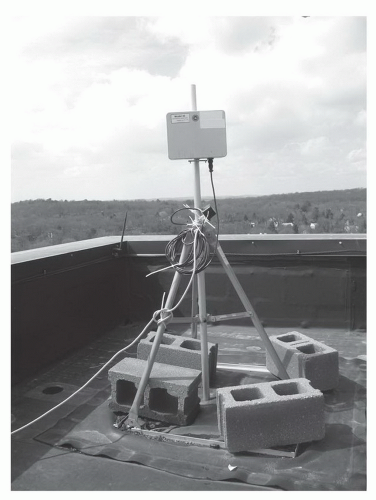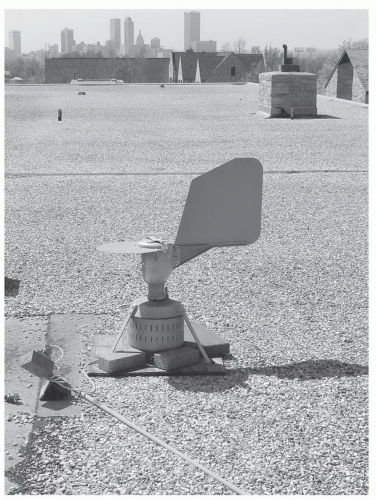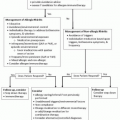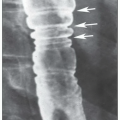Aeroallergens and Environmental Factors
Estelle Levetin
William A. Neaville
Robert Ausdenmoore
Robert K. Bush
AEROALLERGENS
Aeroallergens are relatively large and complex particles, such as pollen, fungal spores, insect parts, animal dander, plant fragments, and house dust mites, that are capable of eliciting allergic reactions in susceptible persons. These particles contain many molecular components, only some of which are antigenic. When specific antigenic components have been identified, they usually are proteins with carbohydrate subunits and have a molecular weight of 10,000 to 40,000 D. The antigenicity of these molecules is fundamentally a property of their size, spatial configuration, and chemical groupings. The overall allergic importance of these particles is not only a function of their antigenicity but also of their availability in the environment for contact with susceptible persons and the suitability of particle size for impingement on the respiratory mucosa.
I. SOURCES AND SIZE OF AEROALLERGENS
A. Biogenic particulate matter commonly identifiable in air samples includes pollen grains and fungal spores. Unidentifiable biogenic particulate materials include insect parts, plant fragments, animal dander, and fragmented pollen and fungi. These may be identifiable by immunoassay. Nonbiogenic materials, such as hydrocarbons, dirt, salt crystals, or other particulate substances, especially from neighboring farm or industrial activities, may modify allergic responses but are not aeroallergens. Nonbiogenic, nonparticulate gases such as chlorine, hydrogen sulfide, formaldehyde, gasoline, wood smoke, tobacco smoke, and cooking odors are also not allergens but may influence allergic reactions and act directly as irritants.
B. Most airborne substances of allergic importance identifiable microscopically are between 2 and 60 mm in diameter. Most of these particles (particularly those >15 mm diameter) strike ocular, nasal, and pharyngeal surfaces because of their linear momentum. Because the majority of allergenic particles do not reach the bronchi, it has been postulated that the bronchial pathophysiologic features in asthma result from a bronchial reflex stimulated by nasopharyngeal receptors. Alternatively, active allergenic material may be eluted from the particles in the nasopharynx and aspirated or may reach the bronchi by a hematogenous route.
II. SAMPLING TECHNIQUES: VOLUMETRIC METHODS
A. Particles heavier than air also exhibit inertial forces, so placing an obstruction in the flow of air causes the particles to impinge on the obstruction. Several sampling techniques take advantage of this fact, but currently these
techniques are not recommended because they do not provide volumetric data and significantly underrepresent small particles.
techniques are not recommended because they do not provide volumetric data and significantly underrepresent small particles.
B. With the rotating arm impactor, a coated surface is rotated for specific periods of time at a fixed and known speed. Then the particles are counted and expressed as pollen grains or spores per cubic meter of air. Such methods reduce the factors of wind velocity and direction. One adaptation, the Rotorod Sampler (Fig. 3-1), involves the use of clear acrylic collector rods coated with a thin layer of silicone grease to enhance retention of impacted particles. Other modifications provide timed intermittent rotation to prevent overloading and shields to cover exposed surfaces between operating intervals.
C. Inertial suction samplers. When a given volume of air is drawn through membrane filters with defined pore sizes or is aspirated through an orifice with a defined size, particles of a given density leave the air stream and impinge on a collecting surface as the air changes direction because of the impasse. One modification, the Burkard (Hirst) spore trap (Fig. 3-2), contains a collecting drum or microscope slide (moving at 2 mm/h) within the trap to allow observations of the diurnal fluctuations in the count. In addition, a rudder vane eliminates the factor of wind direction. Spore
traps are the preferred method for sampling particles over a broad particle size range with the resulting samples analyzed by microscopy or other assays. Other suction-type volumetric samplers, for example, Air Sentinal, employ a filter (GORE-TEX) that can be used to collect airborne particles. Immunochemical assay of the collected material can then be used to quantify specific allergens, for example, ragweed allergen, Amb a 1.
traps are the preferred method for sampling particles over a broad particle size range with the resulting samples analyzed by microscopy or other assays. Other suction-type volumetric samplers, for example, Air Sentinal, employ a filter (GORE-TEX) that can be used to collect airborne particles. Immunochemical assay of the collected material can then be used to quantify specific allergens, for example, ragweed allergen, Amb a 1.
 Figure 3-1. Rotorod (rotating air impactor) air sampler. (Courtesy Rose Vrtis, University of Wisconsin – Madison.) |
 Figure 3-2. Burkard spore trap volumetric air sampler. (Courtesy Estelle Levetin, University of Tulsa.) |
D. Interpretation of sampling data
1. For most sampling procedures, volumetric samples are preferred. Manuals with identification guidelines are available for pollen and mold spores (see Selected Readings). Tabulation of their concentrations (by counting under the microscope) can help determine seasonal prevalence of common aeroallergens in given locales (see Appendix IV). Correlation of particle counts with clinical symptoms on a given day must be cautiously interpreted. There are great variations in the pollen and mold concentrations within any collection period and within any location. Allergic symptoms may be manifested in an individual because of a high peak concentration nearby even if the total daily count is low from a centrally located sampler. Allergen concentrations may be high as those measured by immunoassay in some circumstances, even though
the pollen or mold concentration by visual count is low. Unfortunately, some news agencies report daily pollen or mold counts to help promote medication advertisements to a lay public unaware of sampling limitations, the important aspects of personal exposure variations, the effects of multiple sensitivities, or complex allergen dose-response relationships.
the pollen or mold concentration by visual count is low. Unfortunately, some news agencies report daily pollen or mold counts to help promote medication advertisements to a lay public unaware of sampling limitations, the important aspects of personal exposure variations, the effects of multiple sensitivities, or complex allergen dose-response relationships.
2. Immunochemical quantitation of allergens in air samples can be made using labeled antibody toward the allergen being measured. Fractions of these allergens can be separated by size by collecting them on filters with progressively smaller pore sizes. Correlations of quantitative data derived by immunochemical means with clinical symptom scores, especially in asthma, are considerably better than the correlation with pollen or mold spore counts. This new, more precise method of quantitating allergen in the air may not only provide better data to correlate with clinical symptoms but also increase the understanding of the effect of antigens not recognizable under the microscope (e.g., dander, fungal fragments, and insect fragments in dwellings and workplaces).
III. POLLEN AEROALLERGENS
Pollen grains are male reproductive structures of seed-bearing plants and function to carry the male gametes (sperm) to the female gametes (egg), which remain on the plant. Pollen transfer for plants with showy, colorful, and fragrant flowers is accomplished by insects (entomophily). In these instances, the pollen is often large, with an adhesive coating. Remarkable adaptations of some plants allow dissemination of pollen by birds, bats, mice, or even snails.
Most pollen types of allergic importance are wind-borne (anemophily). Plants with wind-borne pollen transfers typically have drab, small, inconspicuous, and odorless flowers. Their pollen is usually small, light weight, nonadhesive, and produced in enormous numbers.
Most pollen is shed in the morning hours, but dispersal by wind currents may produce maximal pollen concentrations in the afternoon or early evening. Although pollen grains are viable for only a few hours, nonviable pollen is still an active allergen. A gentle wind can carry pollen of anemophilous plants for many miles and produce high pollen concentrations in urban and metropolitan areas, far from their rural or suburban source. A floristic map and regional pollen guide listing the periods of prevalence and relative importance of various pollen in various regions of the United States and Canada appear in Appendix IV.
A. Weeds. Although many different classes of plants may be considered weeds, such as Polygonaceae (buckwheat family), Amaranthaceae (pigweed and waterhemp family), Chenopodiaceae (goose foot family), and Plantaginaceae (plantain family), plants from within the family Asteraceae (Compositae) are most important from an allergy perspective. Within this family, ragweed (Ambrosia sp.) is the single most important cause, quantitatively and qualitatively, of seasonal allergic rhinitis (hay fever) in the United States. The highest concentrations of ragweed pollen occur in the central plains and eastern agricultural regions. Cultivation of soil as seen in the Midwestern grain fields
allows dense ragweed growth and the greatest seasonal exposure risk for the ragweed pollen-sensitive patient. Ragweed pollen season is typically considered to last 2 to 3 months, with peaks ranging from late August to early October, depending on geographic locale, but climate changes may lengthen these seasons. Peak times for ragweed pollination in the southern United States occur considerably later than in the north. Peak dates occur at the same time for each locale—generally within a 2-week period.
allows dense ragweed growth and the greatest seasonal exposure risk for the ragweed pollen-sensitive patient. Ragweed pollen season is typically considered to last 2 to 3 months, with peaks ranging from late August to early October, depending on geographic locale, but climate changes may lengthen these seasons. Peak times for ragweed pollination in the southern United States occur considerably later than in the north. Peak dates occur at the same time for each locale—generally within a 2-week period.
Amb a 1 (formerly termed antigen E) is a highly reactive fraction of ragweed with a molecular weight of 37,800 D, representing approximately 6% of the extractable protein of ragweed. It is 200 times as active as whole ragweed extract. Another fraction, Amb a 2 (formerly termed antigen K) (molecular weight 38,000 D), is somewhat less potent than Amb a 1 but still produces reactions in almost all ragweed-sensitive patients.
B. Grasses. It is difficult to distinguish the pollen of different grasses solely on the basis of morphology. Consequently, the importance of individual species is largely determined on the basis of total grass pollen counts combined with a knowledge of the regional presence of individual grass species.
1. In general, Bermuda grass is the predominant species throughout the southern half of the United States and the southern Pacific coast regions. In the northeastern and northern Midwestern states, the bulk of the grass pollen usually comes from the blue grass, orchard grass, timothy grass, and redtop (see Appendix IV for individual locales).
2. Grass pollen is seen only during the growing seasons, so that seasonal patterns (spring and summer) are noted in the north, and more perennial patterns are observed in the south. As with weed pollen, grass pollen concentrations are generally low at high altitudes, such as in the Rocky Mountain area. They are also low in the far north regions of Wisconsin, Michigan, and Maine.
3. Regarding the frequency and severity of allergic symptoms, grass pollen ranks second only to ragweed in the United States. In other parts of the world, it is the leading aeroallergen.
Significant cross-sensitivity on skin testing is seen between blue, timothy, orchard, and redtop grasses, but Bermuda grass is antigenically distinct. The extensive cross-reactivity of grass pollen makes skin testing with individual grass extracts unnecessary. Studies indicate that one species of the cross-reactivity grasses is usually sufficient for in vitro diagnosis of grass pollen allergy.
C. Trees. The pollen grains of wind-pollinating (anemophilous) trees are the principal causes of respiratory allergy in this botanical group. Insectpollinating (entomophilous) trees (e.g., ornamental and fruit trees) and some of the anemophilous conifers whose pollen has a thick exine or outer covering (e.g., pine trees) are of minor allergic significance. However, pollen produced from some members of the conifer family Cupressaceae is considered among the most important airborne allergens in many areas.
1. In general, each tree genus produces pollen morphologically distinct from other genera and exhibits marked individual variation with respect to the duration, intensity, and seasonal pattern of pollination. However, there are some exceptions. Members of the Cupressaceae family that include junipers, ceders, and cypress all produce pollen that is not
distinguishable. These pollen types are identified only as Cupressaceae pollen.
distinguishable. These pollen types are identified only as Cupressaceae pollen.
2. Little cross-antigenicity is noted between genera. In addition, clustering of certain genera often occurs within the same floristic zone. As a result of these factors, an allergic patient can have selective sensitivity (frequently only to one genus or a few different genera). Pollen from members of the Fagales order are important sources of allergens in spring in the temperate climate zone. Bet v 1 from birch pollen is an important allergen from this class and has been extensively studied. There are common cross-sensitizations to food in birch-allergic patients. A well-known example is with raw apple. This is commonly known as the oral allergy syndrome (pollen-food syndrome).
3. In general, the period of pollination within a given locality is relatively short, with the result that tree-sensitive patients often exhibit correspondingly brief periods of discomfort.
Pollination occurs before, during, or shortly after leaves develop in deciduous trees in most species. In more temperate climates, tree pollination concludes by late spring when the trees are fully leaved; in warmer areas, this season may be extended (see Appendix IV). However, it should be noted that some trees produce pollen at other times. There are fall-pollinating species of elm (Ulmus) that are commonly used as ornamental. In addition, some species of juniper (Juniperus) also pollinate in fall or winter.
IV. FUNGI AS AEROALLERGENS
Fungi belong to a kingdom of multicellular eukaryotes separate from the plant and animal kingdom.
Mold is a term frequently used interchangeably with fungus, but the term fungus is correct, whereas mold more properly refers to amorphous masses of fungi not necessarily of the same type. Despite their simplicity, fungi are among the most successful organisms on earth. They exist in large numbers in almost every environment—dry areas virtually devoid of water or other life, moist areas with wide temperature extremes, in soil, and in fresh water or salt water. Fungi are either saprophytic (obtaining food from dead organic material) or parasitic (feeding on viable tissue).
Stay updated, free articles. Join our Telegram channel

Full access? Get Clinical Tree





